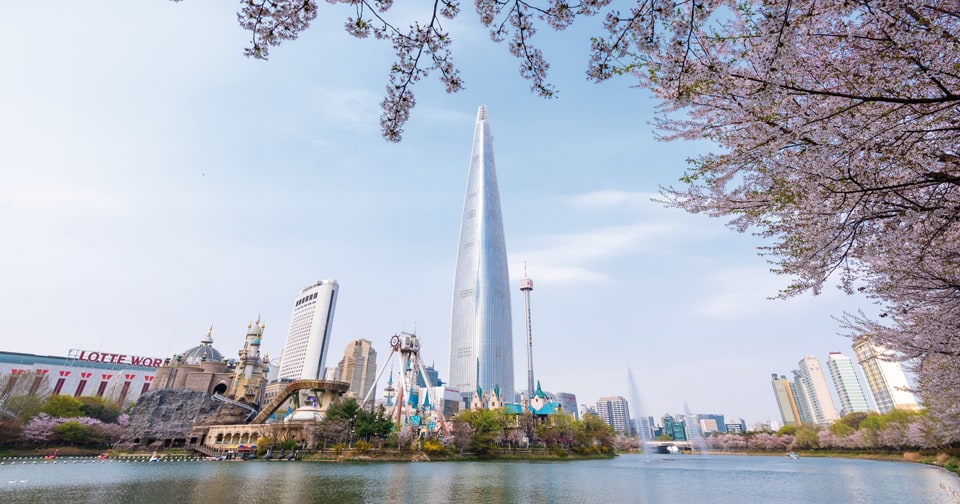
Located on floors 76 to 101 of the Lotte World Tower – the fifth tallest skyscraper in the world and the tallest in Korea – Lotte Hotels & Resorts’ newest hotel Signiel Seoul, which opened in April 2017, is ambitious in much more than its altitude.
All 235 state-of-the-art guest rooms boast panoramic views over Seoul, the grand ballroom with its 7.8-metre-tall ceilings is the world’s highest and the hotel’s culinary offer, which can be enjoyed at 342 metres above ground level, includes stylish French, all-day dining concept STAY by three Michelin-starred Yannick Alléno and one Michelin-starred Korean restaurant Bicena.
Back in late 2014, it was Malaysia-based kitchen and laundry consultancy DiSHES that was charged with supplying the kitchens for the majority of the hotel’s foodservice offer including STAY, the ballroom, the bakery, the employee cafeteria and room service. And while Shahriffa Jari, the consultant in charge of the project, remembers various aspects of it sounding challenging from the outset – the budget and the fact all equipment had to be electric, to name a couple – it was the sheer height of the operation that really struck her.
“I had never done kitchens at this height; the highest I’d done before was on level five,” she recalls. But never one to be deterred by a challenge – “This was exciting!” she grins – Jari set to work, together with equipment dealer Daeryung and a slew of other contractors, to deliver a behind-the-scenes solution to match the landmark building’s spectacular exterior.
Three key challenges
Deciding on equipment providers was one of the easiest parts of the job. The client requested high-end products to satisfy the needs of the hotel’s world-class chefs and on Jari’s specification, Daeryung sales director Brandon Nam ended up selecting products from Ambach, Fujimak, Halton, Irinox, Hobart, Hoshizaki and Melitta, including everything from a Josper Grill to heavy-duty Bratt pans, kettles and combi ovens.
At STAY, a combination of pieces from Ambach’s System 850, System 700 and System 900 lines was chosen for both front and back of house operations. The South Tyrolian company’s wide range of products and modular configuration made it an ideal partner for a project of this scope. Jari also rates Ambach’s workmanship, focus on energy efficiency and reliable after-sales service.
The first challenge was that everything had to be electric due to Korean regulations that forbid gas appliances in skyscrapers. As the chefs employed by the hotel were used to cooking with gas, this meant lengthy design discussions between client, dealer, consultant and the equipment providers to ensure nothing was too unfamiliar to the kitchen staff and everything would be used to its maximum potential.
Challenge number two – and Jari’s initial concern – was the sheer height of the hotel. Kitchens needed to be installed on levels 76, 77, 79, 81 and 82 of the building and the elevators were not designed to carry the sort of equipment that was required – particularly for the banquet kitchen.
“The ballroom, which is on level 76, is huge and our goods came in on level 77, so we had to bring them down a level,” Jari says. “I was scared about the loading because we had heavy equipment like kettles, bratt pans and combi steamers. It was a challenge.”
It was a similar story up on floor 81, where Ambach had been asked to supply a hygienic one-piece island for STAY. “The cooking suite was delivered in four pieces and assembled by Ambach engineers on site,” recalls the company’s managing director Maurizio Vianello. “The challenge was keeping the same level of hygiene as a single-piece top with modular equipment, but thanks to our Ambach joining system, the finish on the surface was seamless.”
The final restriction the contractors and consultants had to work around was the ceiling height of the kitchens, which was around 2.2m. “We had to work with manufacturers and our factory customising hoods and equipment to make an environmentally friendly cooking zone for chefs,” says Nam. “We also worked with the interior design company to finish the ceiling together with our ventilation hood installation and cooperated with the HVAC company and MEP companies because, in order to install the hood as high as possible, the hood location in the ceiling needed to be clear.”
To make certain everything went to plan, Nam had a designer and engineer assigned to the site for four months full time. “They had discussions and meetings with the construction related companies to make sure all our requests were in their plan, so there wouldn’t be any problems during installation,” he explains.
Open lines of communication
The teamwork and dedication demonstrated by all parties involved was crucial to the success of the project. “We worked closely with the structural team and the MEP consultant to ensure we had everything we needed especially when it came to the grease discharge, the plumbing service capture, the electrical supply for each kitchen and ensuring the service lift was able to transport all the kitchen equipment,” Jari says.
It also helped that the client was the operator of the hotel and that Nam and his team, who were appointed by the owner, were experienced in the sector and kept lines of communication open at all times. “We had very good support from the client, especially on the detailing from every aspect of the design criteria and flow development,” Jari continues. “The final product was about 95% similar to the original plan and the contractor always interacted with us for approval if any problems arose.”
For Vianello’s part, the big lesson learnt from this project was that the earlier equipment providers are involved in the process, the better the solution turns out to be. “We were involved from the beginning and that is the reason we provided such a good solution – the consultant, the owner, the contractor and us defined everything together,” he explains, adding that now that Ambach has opened an office in Thailand for the Asia Pacific region, the company will be able to work even more closely with its partners in the future.
The height of the hotel may have presented numerous challenges from the logistical perspective, but it also resulted in a finished product that both allows diners to experience Michelin-quality food 342 metres up in the air and chefs to enjoy unparalleled views while preparing it.
“Most restaurant kitchens in skyscrapers are located in the middle of the building or the view is blocked,” Nam says. “The head chef of STAY said he had never seen a kitchen with such a quality view of the whole city. Standing next to the Ambach cooking island, which is right next to the window on the 81st floor, means the chefs can cook with pride. I believe this will lead to the best quality food.”
Elly Earls




